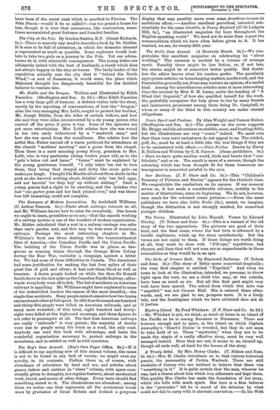The Romance of Modern Locomotion. By Archibald Williams. (C. Arthur
Pearson. 5s.)—Facts about railways interest us all, and Mr. Williams knows how to cater for everybody. One lesson we ought to learn, grumblers as we are,—that the smooth working of a railway system is one of the wonders of modern organisation. Mr. Bidder calculated that a seat in a railway carriage was safer than one's garden seat, and this may be true even of American railways. Perhaps the most interesting chapters in Mr. Williams's book are those dealing with the transcontinental lines of America,—the Canadian Pacific and the Union Pacific. The building of the Union Pacific was in places as dan- gerous as running trains through the Orange River Colony during the Boer War, veritably a campaign against a bitter foe. We had none of these difficulties in Canada. The Americans had some justification for making the last four spikes of their great line of gold and silver; it had cost them blood as well as treasure. A dozen people looked on while the then Sir Donald Smith drove in the last spike on the Canadian Pacific Railway; after- wards everybody went off to fish. The list of accidents on American railways is appalling. Mr. Williams might have explained to some of his untravelled readers the reason of the most dreadful,—the single-line accidents. Many people cannot conceive how two trains can meet each other at full speed. In 1901 four thousand one hundred and thirty-five people were killed on American railroads, and as many more wounded; of this total, eight hundred and thirty- eight were killed at the high-road crossings, and these figures do not refer to passengers at all. The fact that American railways are really "railroads" is very patent; the majority of deaths were due to people using the track as a road, the only road. Anybody can read this book with advantage, and learn the wonderful organisation necessary to protect railways in the mountains, and in settled as well as wild countries.


























































 Previous page
Previous page